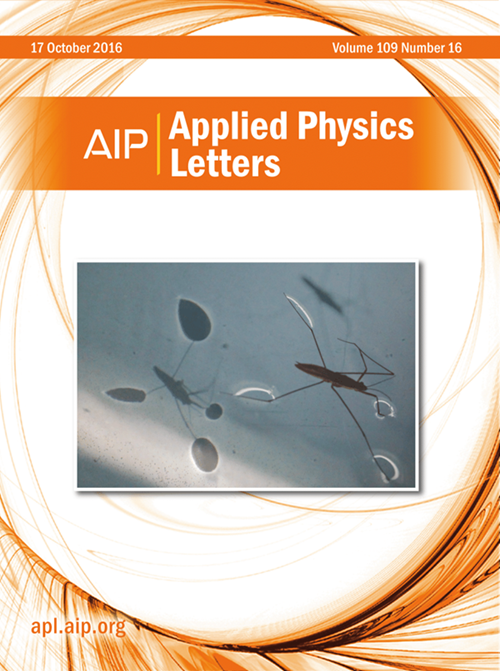Reversible solar heating and radiative cooling coupled with latent heat for self-adaptive thermoregulation
IF 3.5
2区 物理与天体物理
Q2 PHYSICS, APPLIED
引用次数: 0
Abstract
Passive solar heating and radiative cooling attracted lots of attention in global energy consumption reduction due to their unique electricity-free advantage. However, static single radiation cooling or solar heating would lead to over-cooling or over-heating in cold or hot weather, respectively. How to achieve effective self-adaptive thermoregulation is critical for dynamic thermal management. Hence, in this work, a self-adaptive thermoregulation strategy was designed by coupling latent heat storage or release with reversible solar heating and radiative cooling. A commercial memory alloy could realize self-adaptive thermoregulation at the critical temperature between radiative cooling with high solar reflectance R¯solar = 0.95 and thermal emittance ε¯LWIR = 0.93, and solar heating with high solar absorptance α¯solar = 0.92 and low thermal emittance ε¯IR = 0.08. High thermal conductive phase change material could further improve the thermoregulation performance with a latent heat of ∼136 J g−1, and thermal conductivity of 3.4 W m−1 K−1, resulting in a superior heating performance than the single solar heating (39.9 vs 36.9 °C) and superior cooling performance than the single radiative cooling (33.8 vs 35.5 °C). The maximum heating temperature increase could be 12.7 °C in the cold situation, and the temperature drop could be 8.3 °C in the hot situation. Energy consumption calculation showed that the designed sample could save 68%–90% of annual energy consumption compared with the common roof, indicating that coupling spectral regulation with the latent heat can greatly improve the self-adaptive thermoregulation performance and save the total energy consumption in thermal management.被动式太阳能加热和辐射制冷因其独特的无电优势,在全球降低能耗方面备受关注。然而,静态的单一辐射制冷或太阳能加热在寒冷或炎热的天气下会分别导致过冷或过热。如何实现有效的自适应热调节对于动态热管理至关重要。因此,在这项工作中,通过将潜热储存或释放与可逆的太阳能加热和辐射冷却结合起来,设计了一种自适应热调节策略。商用记忆合金可在高太阳反射率 R¯solar = 0.95 和热辐射率 ε¯LWIR = 0.93 的辐射冷却与高太阳吸收率 α¯solar = 0.92 和低热辐射率 ε¯IR = 0.08 的太阳加热临界温度之间实现自适应热调节。高导热相变材料的潜热为 ∼136 J g-1,导热系数为 3.4 W m-1 K-1,可进一步提高温度调节性能,使加热性能优于单一太阳能加热(39.9 vs 36.9 °C),冷却性能优于单一辐射冷却(33.8 vs 35.5 °C)。在寒冷条件下,加热温度最高可升高 12.7 °C,在炎热条件下,温度最低可降低 8.3 °C。能耗计算表明,与普通屋顶相比,所设计的样品每年可节省 68%-90% 的能耗,这表明将光谱调节与潜热耦合可大大提高自适应温度调节性能,节省热管理的总能耗。
本文章由计算机程序翻译,如有差异,请以英文原文为准。
求助全文
约1分钟内获得全文
求助全文
来源期刊

Applied Physics Letters
物理-物理:应用
CiteScore
6.40
自引率
10.00%
发文量
1821
审稿时长
1.6 months
期刊介绍:
Applied Physics Letters (APL) features concise, up-to-date reports on significant new findings in applied physics. Emphasizing rapid dissemination of key data and new physical insights, APL offers prompt publication of new experimental and theoretical papers reporting applications of physics phenomena to all branches of science, engineering, and modern technology.
In addition to regular articles, the journal also publishes invited Fast Track, Perspectives, and in-depth Editorials which report on cutting-edge areas in applied physics.
APL Perspectives are forward-looking invited letters which highlight recent developments or discoveries. Emphasis is placed on very recent developments, potentially disruptive technologies, open questions and possible solutions. They also include a mini-roadmap detailing where the community should direct efforts in order for the phenomena to be viable for application and the challenges associated with meeting that performance threshold. Perspectives are characterized by personal viewpoints and opinions of recognized experts in the field.
Fast Track articles are invited original research articles that report results that are particularly novel and important or provide a significant advancement in an emerging field. Because of the urgency and scientific importance of the work, the peer review process is accelerated. If, during the review process, it becomes apparent that the paper does not meet the Fast Track criterion, it is returned to a normal track.
 求助内容:
求助内容: 应助结果提醒方式:
应助结果提醒方式:


